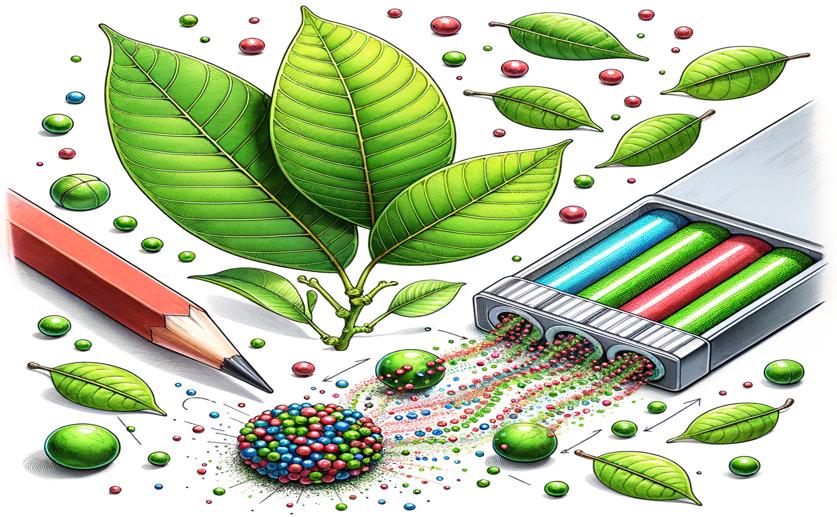Green-Made Magnetic Particles with Guava Leaf Enzyme for Cleaning Dyes

Image Source: Natural Science News, 2024
Key Findings
- Researchers at Galala University developed a nanocomposite that can break down pollutants and fight bacteria
- The nanocomposite removed 96% of a harmful dye from water, showing promise for pollution cleanup
- It also prevented up to 96.6% of bacterial biofilm formation, offering potential for medical applications
In recent years, the synthesis of nanoparticles using environmentally friendly methods has become an important field of research, with applications spanning from environmental remediation to the medical industry. A study from Galala University[1] has made significant strides in this arena by developing a novel nanocomposite with the potential to address both pollution and bacterial infections effectively.
The research focuses on zinc ferrite nanoparticles (ZnF NPs), which are synthesized using an extract from the leaves of the Psidium guajava, commonly known as the guava plant. This method aligns with the principles of green chemistry, which prioritize the use of non-toxic materials and sustainable processes[2]. The ZnF NPs were then coated with citric acid (CA) and had an enzyme, lipase (LP), immobilized on their surface to create a modified ZnF-CA-LP nanocomposite (NCs).
The significance of using lipase lies in its ability to catalyze reactions efficiently under mild conditions, which is beneficial for industrial processes[3]. Moreover, the immobilization of enzymes on nanoparticles can enhance their stability and reusability, making them more cost-effective[3].
The study's findings reveal that the ZnF-CA-LP NCs have a crystallite size of approximately 35.0 nm and exhibit remarkable photocatalytic activity. In practical terms, this means they can effectively break down pollutants, such as the Methylene blue dye (MB), which is commonly used in industries and can be harmful to aquatic life. The nanocomposite achieved a 96.0% removal rate of MB from an aqueous solution, demonstrating its potential for cleaning up environmental pollutants.
Additionally, the ZnF-CA-LP NCs were found to possess antioxidant properties, which were measured using a compound called 1,1-diphenyl-2-picryl hydrazyl (DPPH) that serves as a source of free radicals. The ability to neutralize these radicals indicates that the nanocomposite could have applications in protecting cells from oxidative stress, a factor in many diseases.
In terms of biomedical applications, the research also explored the nanocomposite's effectiveness against bacterial pathogens. The results showed strong antibacterial and antibiofilm activities against both gram-positive Staphylococcus aureus and gram-negative Escherichia coli. The ZnF-CA-LP NCs not only inhibited the growth of these bacteria but also prevented the formation of biofilms, which are protective layers that bacteria build to shield themselves from antibiotics and the host immune system. The antibiofilm percentages against S. aureus and E. coli were 88.4% and 96.6%, respectively, which is particularly relevant for medical devices where biofilm formation can lead to serious infections.
The methods used in this study are in line with previous research that has identified algae as efficient bio-factories for nanoparticle synthesis, utilizing their natural ability to accumulate metals and reduce metal ions[4]. The use of plant extracts for the green synthesis of nanoparticles is a novel approach that complements the microbial methods previously explored[2]. This study builds upon these earlier findings by not only synthesizing nanoparticles in an eco-friendly manner but also functionalizing them with an enzyme to enhance their utility.
In conclusion, the research from Galala University presents a promising advancement in the field of nanotechnology. By synthesizing a nanocomposite that can tackle environmental pollutants and combat bacterial infections, this study could pave the way for new applications in water treatment and the medical field. The green synthesis approach ensures that the process is sustainable and less harmful to the environment, aligning with the growing demand for eco-friendly technologies.
EnvironmentBiotechPlant Science
References
Main Study
1) Immobilized lipase enzyme on green synthesized magnetic nanoparticles using Psidium guava leaves for dye degradation and antimicrobial activities.
Published 17th April, 2024
Journal: Scientific reports
Issue: Vol 14, Issue 1, Apr 2024
Related Studies
Related Articles





 9th April, 2024 | Jim Crocker
9th April, 2024 | Jim Crocker